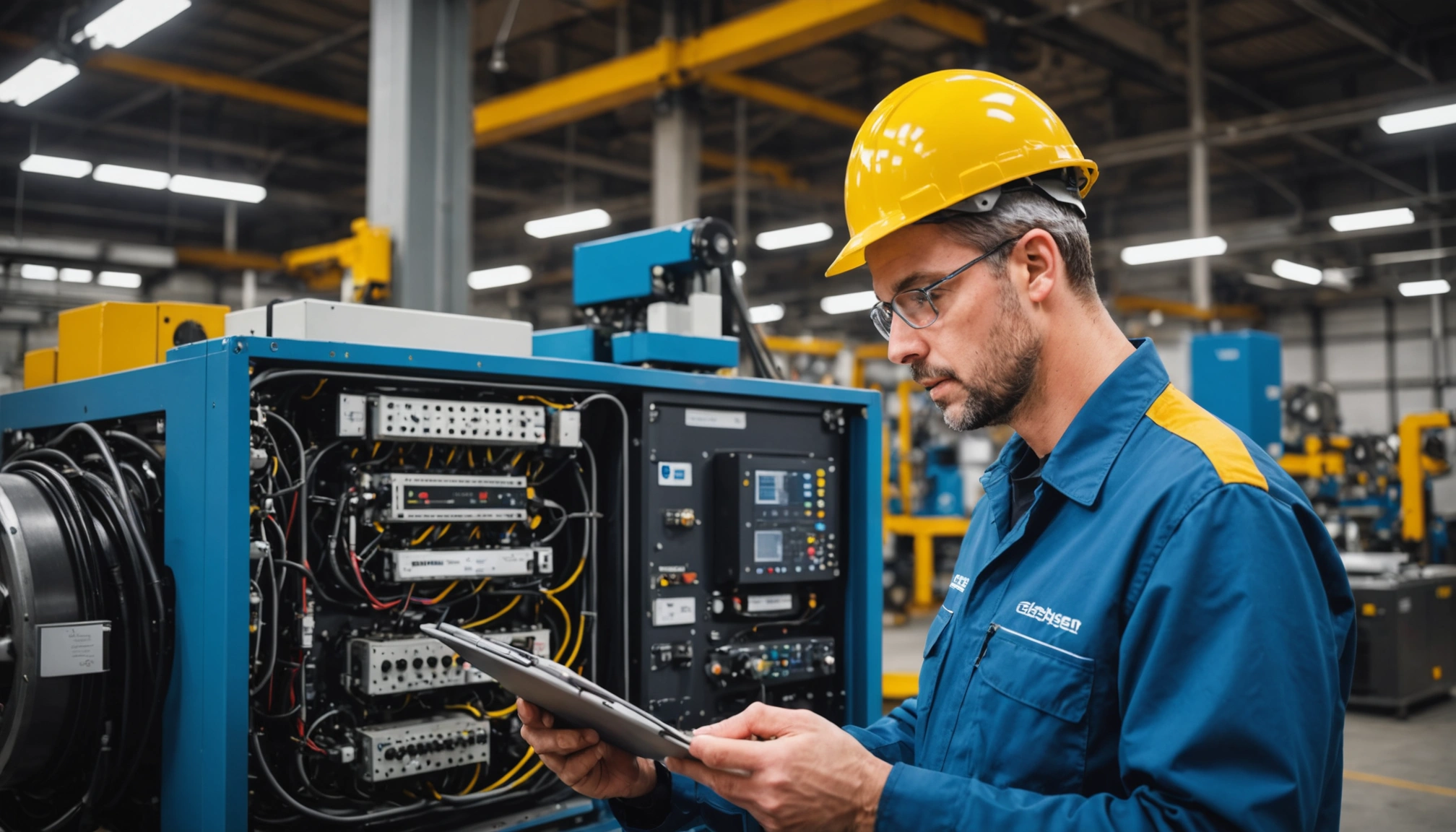
The integration of cutting-edge technology has become a cornerstone of operational success. By harnessing the capabilities of advanced algorithms, organizations are able to anticipate and prevent equipment failures, ensuring seamless production processes and increased reliability. The strategic implementation of Artificial Intelligence (AI) models has redefined traditional maintenance practices, enabling predictive interventions and mitigating costly downtimes. This proactive approach not only optimizes operational efficiency but also streamlines resource allocation, ultimately driving overall productivity gains. Through the synergy of AI advancements and predictive maintenance strategies, businesses can unlock new levels of equipment performance and longevity, setting the stage for sustained growth and competitiveness. Embark on a journey to discover the transformative impact of AI models in reshaping the landscape of predictive maintenance, ushering in a future of enhanced reliability and sustainability across diverse industries.
Benefits of AI Models in Predictive Maintenance
Predictive maintenance is a proactive approach to maintenance that aims to predict when equipment failure might occur so that maintenance can be performed just in time. AI models play a crucial role in predictive maintenance, offering various benefits that organizations can leverage to optimize their maintenance strategies and improve operational efficiency.
Improved Equipment Uptime
One of the key benefits of utilizing AI models in predictive maintenance is the significant improvement in equipment uptime. By continuously analyzing data from sensors and other sources, AI models can detect patterns and anomalies that indicate potential issues before they escalate into full-blown failures. This early detection enables maintenance teams to address problems proactively, minimizing unplanned downtime and maximizing equipment availability.
Cost Savings through Preventive Measures
Implementing AI models for predictive maintenance can result in substantial cost savings for organizations. By predicting when maintenance is required and scheduling it in advance, companies can avoid costly breakdowns that lead to emergency repairs and production stoppages. This shift from reactive to proactive maintenance helps reduce overall maintenance costs and extends the lifespan of equipment, ultimately improving the bottom line.
Enhanced Safety
AI models not only contribute to improved operational efficiency but also enhance safety in the workplace. By identifying potential safety hazards through data analysis, predictive maintenance powered by AI can help prevent accidents and create a safer working environment for employees. This proactive approach to maintenance minimizes risks associated with equipment failures, ensuring that operations run smoothly and securely.
Reduced Downtime
Another significant advantage of AI models in predictive maintenance is the reduction of downtime. By predicting when maintenance is needed and addressing issues before they escalate, organizations can minimize downtime associated with equipment failures. This increased reliability and availability of assets translate into improved productivity and customer satisfaction, as businesses can deliver consistent services without disruption.
The benefits of leveraging AI models in predictive maintenance are undeniable. From enhancing equipment uptime and reducing costs to improving safety and minimizing downtime, AI-driven predictive maintenance offers a competitive edge to organizations looking to streamline their maintenance practices and achieve operational excellence.
Challenges in Implementing AI Models for Predictive Maintenance
Data Quality and Integration
- The Significance of High-Quality Data: The foundation of any successful AI model for predictive maintenance lies in the quality of the data used for training. Without accurate and reliable data from diverse sources like sensors, equipment logs, and maintenance records, the model’s predictive capabilities are compromised.
- Data Integration Challenges: Integrating data from multiple sources poses a significant challenge. Ensuring seamless data flow and compatibility between different data formats and structures is crucial for building comprehensive AI models.
- Data Cleaning and Preprocessing: Before training AI models, data cleaning and preprocessing are essential steps to ensure the data is free from inconsistencies, errors, and missing values. Robust preprocessing techniques enhance the quality of input data and improve the model’s performance.
Model Training and Adaptation
- Complexities in Model Training: Training AI models for predictive maintenance involves intricate processes to analyze historical data and identify patterns that signal potential maintenance needs. Implementing algorithms that can accurately interpret these patterns is a critical aspect of model training.
- Continuous Model Evaluation: Regular evaluation of AI models is necessary to assess their performance and identify areas for improvement. Metrics such as accuracy, precision, and recall help gauge the model’s effectiveness in predicting maintenance requirements.
- Transfer Learning Techniques: Leveraging transfer learning can expedite the training process by utilizing pre-trained models and adapting them to the specific maintenance tasks. Transfer learning reduces the need for large volumes of task-specific data and accelerates model deployment.
Interpretability and Explainability
- Enhancing Model Interpretability: One of the primary challenges in implementing AI models for predictive maintenance is making them interpretable to non-technical personnel. Developing visualization tools and explanatory interfaces can aid in understanding complex model outputs.
- Importance of Explainability: For effective decision-making, it is essential that maintenance personnel and decision-makers understand how AI models generate predictions. Transparent and explainable AI processes build trust and confidence in the model’s recommendations.
- Model Explainability Techniques: Techniques such as feature importance analysis, SHAP values, and LIME (Local Interpretable Model-agnostic Explanations) can provide insights into the factors influencing the model’s predictions. These methods help stakeholders comprehend the rationale behind the model’s decisions.
Addressing these challenges in implementing AI models for predictive maintenance is crucial for maximizing the efficiency and effectiveness of maintenance operations. By prioritizing data quality, continuous model adaptation, and interpretability, organizations can harness the power of AI to enhance equipment reliability, reduce downtime, and optimize maintenance schedules.
Best Practices for Deploying AI Models in Predictive Maintenance
As industries increasingly adopt artificial intelligence (AI) for predictive maintenance, it becomes imperative to implement best practices for the successful deployment and utilization of AI models. In this blog section, we will delve deeper into the best practices that organizations can adopt to maximize the benefits of AI in predictive maintenance:.
Leveraging IoT Sensors for Comprehensive Data Collection
Effective predictive maintenance heavily relies on real-time data availability. By harnessing the power of Internet of Things (IoT) sensors, organizations can gather a vast amount of data related to the condition of equipment and machinery. This data serves as the cornerstone for training AI models, enabling proactive maintenance measures that can prevent potential failures. Additionally, IoT sensors can provide insights into usage patterns, environmental conditions, and operational parameters, contributing to a more holistic view of equipment health.
Ensuring Continuous Model Monitoring and Feedback Loop Implementation
AI models used in predictive maintenance need to undergo continuous monitoring and refinement to ensure their sustained performance. Establishing a robust monitoring system that tracks the performance metrics of AI models is essential for detecting any deviations or drops in accuracy. Moreover, setting up feedback loops that incorporate inputs from maintenance teams can further enhance the predictive capabilities of AI models. This iterative process of monitoring and feedback fosters model improvement over time, making them more adept at identifying potential issues before they escalate.
Facilitating Collaboration between Data Scientists and Maintenance Teams
The successful deployment of AI models in predictive maintenance relies on fostering strong collaboration between data scientists and maintenance personnel. While data scientists are responsible for the development and optimization of AI models, maintenance teams contribute valuable domain expertise and operational insights. Encouraging open communication and knowledge sharing between these two groups ensures that AI models are aligned with operational requirements and enhance maintenance practices. This collaboration can also lead to the identification of new opportunities for predictive maintenance applications and the refinement of existing models.
Embracing Explainable AI for Transparency and Trust
Integrating explainable AI methodologies into predictive maintenance models enhances transparency by providing clear rationale behind the model’s predictions. This transparency not only builds trust among stakeholders but also aids in decision-making processes related to maintenance activities. By understanding the factors influencing the AI model’s recommendations, maintenance teams can make well-informed decisions that optimize equipment performance and reliability.
Adhering to these best practices empowers organizations to fully leverage the potential of AI in predictive maintenance, driving operational efficiency, minimizing downtime, and optimizing costs. Embracing a data-driven culture and a collaborative approach to AI deployment are key to unlocking the transformative benefits of AI in predictive maintenance applications.
Future Outlook and Trends in AI-Powered Predictive Maintenance
The integration of Machine Learning (ML) and Artificial Intelligence (AI) has revolutionized predictive maintenance strategies across industries. This blog section delves deeper into the future outlook and emerging trends in AI-powered predictive maintenance.
Integration of Machine Learning and AI for Enhanced Predictions
The seamless integration of Machine Learning and Artificial Intelligence has significantly enhanced the accuracy and efficiency of predictive maintenance processes. By combining ML algorithms with AI capabilities, organizations can analyze vast datasets to predict equipment failures with greater precision. This proactive approach not only minimizes downtime and maintenance costs but also boosts overall operational efficiency and asset reliability.
Adoption of Edge Computing for Real-time Maintenance Insights
In the era of IoT proliferation, the adoption of edge computing has become instrumental in providing real-time maintenance insights. Edge computing facilitates data processing at the source, reducing latency and enabling quick decision-making based on live equipment performance data. AI-powered predictive maintenance solutions at the edge offer instant alerts and actionable recommendations, empowering maintenance teams to preemptively address potential issues before they escalate.
Predictive Maintenance as a Service (PMaaS) Solutions
The evolution of Predictive Maintenance as a Service (PMaaS) solutions is reshaping traditional maintenance paradigms. Cloud-based PMaaS platforms leverage advanced AI and ML algorithms to offer predictive maintenance capabilities as a scalable service. Through subscription-based models, organizations can access predictive analytics tools, anomaly detection algorithms, and predictive modeling frameworks without substantial upfront investments, driving operational efficiency and cost savings.
Enhanced Data Security Measures in AI-powered Predictive Maintenance
With the increasing reliance on AI for predictive maintenance, ensuring robust data security measures is paramount. Organizations are focusing on implementing advanced encryption techniques, secure data storage protocols, and stringent access controls to safeguard sensitive maintenance data. By prioritizing data security, businesses can mitigate the risks associated with potential cyber threats and data breaches, fostering trust and reliability in AI-powered predictive maintenance systems.
The future of predictive maintenance hinges on the synergistic amalgamation of AI technologies, the widespread adoption of edge computing for real-time insights, the proliferation of PMaaS solutions, and the reinforcement of data security measures. By embracing these trends and leveraging AI-powered predictive maintenance tools, organizations can proactively optimize their maintenance practices, enhance operational efficiency, and achieve sustainable growth in an increasingly competitive market landscape.
Conclusion
Harnessing the power of AI models can truly supercharge predictive maintenance efforts in industries. By leveraging advanced algorithms and machine learning techniques, organizations can accurately predict equipment failures, optimize maintenance schedules, reduce downtime, and ultimately save costs. The integration of AI models in predictive maintenance is not just a trend but a necessity for modern businesses looking to stay competitive and efficient in today’s fast-paced industrial landscape.







